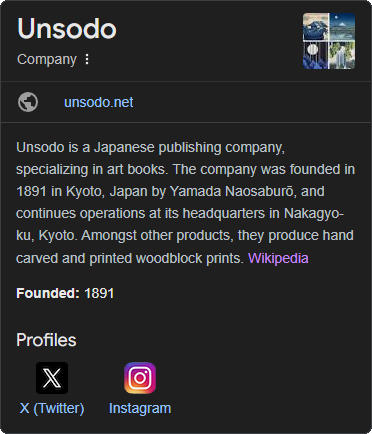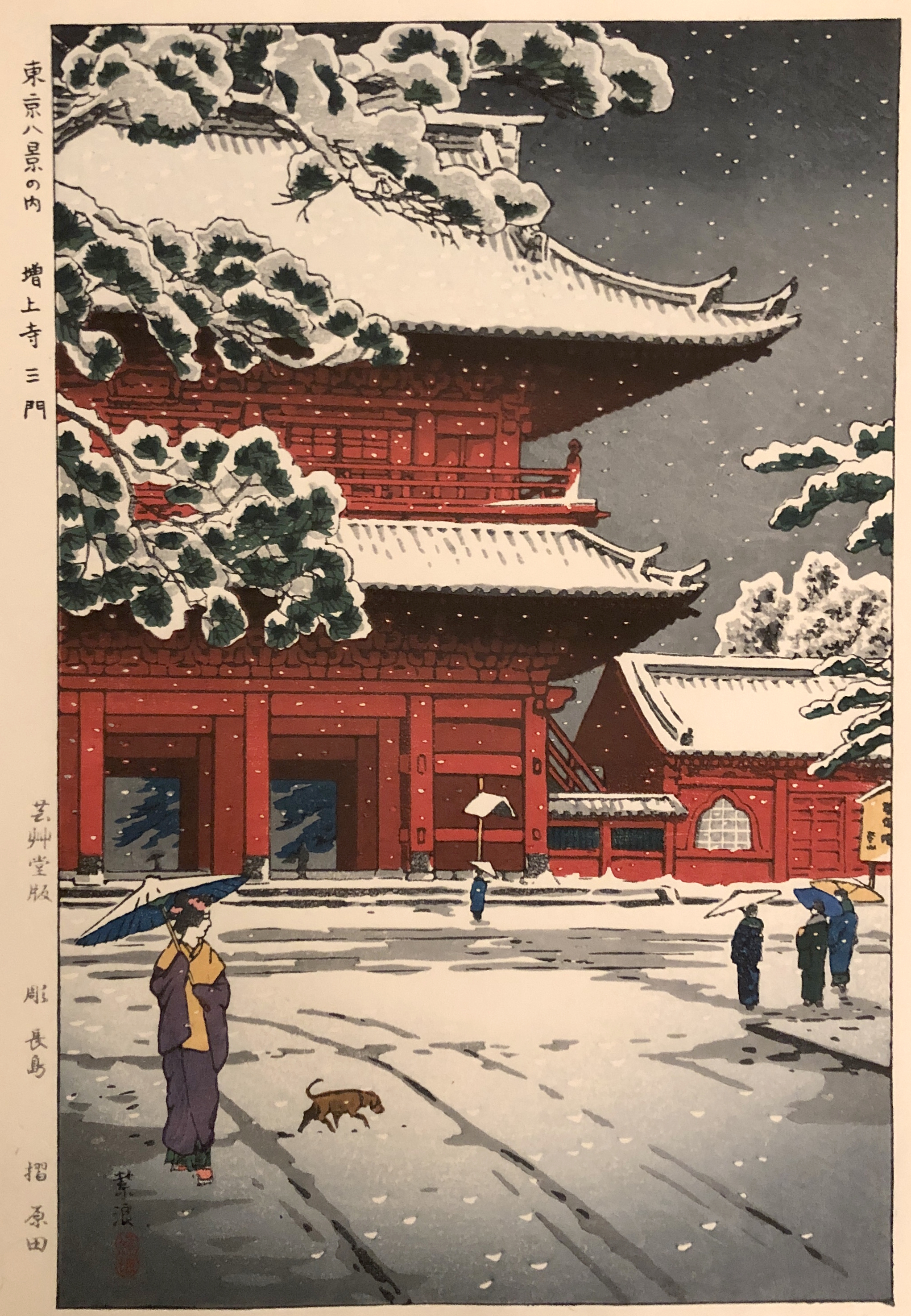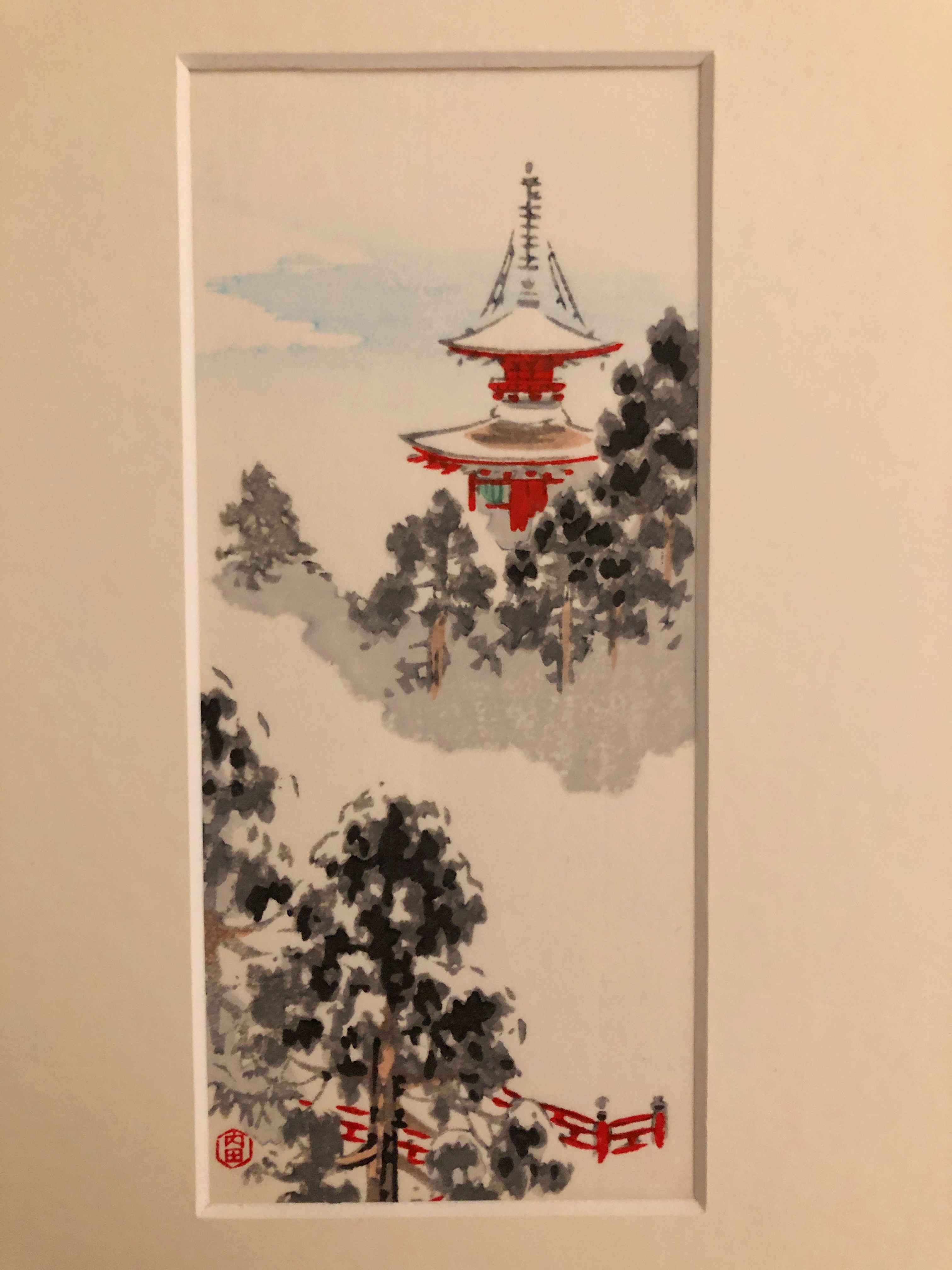Zojoji, Unsodo & Wikipedia
Every now and again I like to purchase myself Japanese woodblock prints, or ukiyo-e. This is my first post about these purchases - who knows if more will come. This particular purchase was a christmas gift to myself, and I think it reflects my favourite season well.
The Print
| Details | |
|---|---|
| Title | The Main Gate of Zojoji Temple |
| Artist | Kasamatsu Shiro (1898 - 1991) |
| Series | Eight Views of Tokyo |
| First Publication Date | 1953 |
| Publication Date | 2010+ |
| Purchase Date | 04 Dec. 2023 |
I found this print while adventuring to Yokimono Japanese Christmas Market in early December of 2023. I’d seen the advert for the market on a flyer and was too tempted by the combination of an untravelled area of London and a Japanese market not to attend. I didn’t know what would be at the festival, but it was a pleasant surprise in every way.
One of the pop-up shops of note was that of The Japanese Gallery, Angel. I’d known of them for a while, but never gone to their shop, despite living reasonably to it. I took the plunge at this event and was rewarded with lots of beautiful prints to browse, and pleasant conversations with the staff. I had no real intention of splashing any cash upon entry, but was subdued by the gorgeous, saturated, winter prints and the passion of the staff.
This particular print was the one which really caught my eye, probably due to the snowy setting; incredibly saturdate reds; and calm atmosphere. I knew that it could not be an original printing due to the price being only ~£140 - the quality was as if it were printed the day before I arrived. No, this had to be a reproduction of some kind.
I enquired to one of the staff at the pop-up about the publisher, as a quick search online came up with nothing. That is when I first heard about Unsodo. I couldn’t quite catch the name at the time, but it was explained to me that this print was produced from the original carvers and blocks that the original imprints made from. They described the publisher as well trusted, and as authentic as a reprint can get. I thanked them for the information and said I’d take some time to walk around the rest of the market while I ponder whether to purchase the print.
While combatting my financial concerns (just because the print is cheap for it’s quality, doesn’t mean it’s cheap for me!), I was also furiously searching on my phone for any information I could find about this publishing company. I was confused why I could barely find anything if they were just a trusted and long-standing publishing house.
Regardless, upon my return to the pop-up shop, I was fed the information that this was the last of this print in their stock, and I finally gave in to purchasing it. While I was at it, I got a cheaper, smaller print too.
Uncovering Unsodo
Upon aquiring a new print, I take extreme joy in doing everything I can to track down every detail about the item. This time was no exception, however, my focus was unusually dominated by the publishing house, rather than the print itself. The print is relatively well-known, and it was not hard to find details on the artist, series, etc.
Initially, most of what I could find about Unsodo was from their website. It’s a painfully slow website with some questionable translations in to English. From their about page:
Unsodo was founded in Kyoto in 1891 as an art book publisher.The only publisher in Japan to publish handrail woodblock books,
We make various art books and crafts by utilizing the technology.
The only other sources of information on the company that I could find was archaic blog posts and obscure articles. I’ll go over some.
Ukiyo-e Gallery have a great blog post on the seals of Unsodo. They, along with the help of my Japanese tutor, allowed me to decypher the following seals on my print:

I believe “han” means “printing blocks” or “edition”, and the blog hints that the carver’s full name could be Nagashima Michio. I was not able to find any information on printer.
I also managed to find an article in the british library that goes in to the publisher’s history in glorious detail. It’s titled Unsōdō and the evolution of design book publishing in Japan. The article covers Unsodo’s transision from Kimono design publisher to print publisher, as well as providing insight as to the etymology of the company’s name.
Briefly, Unsodo (芸艸堂) contains a combination of the kanji 芸艸 (unsō), meaning Rue, and 堂 (dō), a suffix used to indicate a building. The use of rue in the name is due to its use in traditional Japanese bookmark production, as a way to deter pests from damaging books.
My First Wikipedia article
Having convinced myself of Unsodo’s authenticity, I wanted to help others find quick information about them in English. I’d only ever made very minor edits to Wikipedia articles before, but I thought submitting a brand new article for Unsodo could be the way to go!
I went about reading Wikipedia’s helpful guide on submitting one’s first article, and thought it sounded reasonably simple in terms of process - I’d just need to spend a lot of time making sure I abide by the many guidlines for style, citing, etc.
Eventually, I set aside a day to write the article. The time it took was probably exasperated by the nerves of getting something wrong, but it took about half a day overall. Once finished, it entered the Articles for Creation review pool. I didn’t have any issues with the process, and after a week of checking back every day, someone had read and approved my article! It was a great feeling, and the article can be found here! This also came with the unexpected benefit of Google generating a knowledge panel which uses my words for people who search Unsodo:

Glorious.

